As you might know, SparkFun is now in an awesome new building. We have posted some other blogs such as how to build a building, but what we have yet to talk about is our amazing solar array we have on our roof. We currently have 672 Sunpower 327 Watt high efficiency modules, which can produce a peak power rating of 219,744 Watts of direct current with a 97.5% efficiency for DC to AC transfer. That’s a lot of power that we harness right here on our roof!
Google map of our roof.
Solar panels were not always part of the initial plan for this building. It was a cool idea, but it is a large initial investment and Nate (our CEO) thought it best to wait to install them until somewhere down the line. That seemed like a good plan until we were informed that solar panels are heavy, and if we did not design the roof for them it would be a lot of extra work and money when we did want to put them in. So Nate decided to design for the solar panels from the start, which included an extra $18,000 in structural steel for the roof. Since we had the roof for the solar panels ready to go we decided to have the solar array from the start!
After some research, and some very optimistic proposals from solar companies, we chose a company and installed the solar panels, but sadly that was not the end of the complications. The solar array was installed and ready to go long before the electricians were ready to wire them in, which means that they were just sitting there not being used for peak summer months. And even after they were wired into our system and the grid we still had to wait to use them until the monitoring meter was installed.
But they are on our roof and they are working as best they can (we are in the winter months so this is the lowest output for the year).
So I, like many others, was very curious about the way Xcel pays us for our solar power energy. I thought that they would only pay us for excess energy we put back into the grid, that made sense to me, we put energy into the grid we get paid for that energy. And they do pay us for that, at about $0.07 per KWh here in Colorado (that number changes based on the state that you are in/energy provider). Cool - that’s great. What I did not know is that Xcel also pays us for everything our solar array produces regardless of if we use it ourselves or it goes back into the grid. This is a REC (Renewable Energy Certificate) credit, and so they also pay us $0.07 per KWh for this. The reason being is that we just produced energy that they did not have to. THAT’S AWESOME! So now instead of paying about $0.10 per KWh to get energy from the grid, we can use ours and instead get paid $0.07 per KWh. That’s a $0.17 per KWh profit for all the energy that we create for ourselves. And if we did produce extra energy from our solar array, which we are not currently, we would be paid around $0.14 per KWh for it.
Another thing that was a little confusing is what Xcel was billing us for. It makes sense to me that we use some amount of kWh of energy and we get charged (about $0.10) for that. And it also made sense that we are saving money by using power that our PV system produces instead of getting that from the grid. But there were other things on our bills as well. Mainly a “billable demand," and after doing some research and talking with some people from Xcel, I found out that this demand is the peak amount of power that SparkFun uses during that billing period. The units on this are in kW and it is taken over a 15 min interval.
So this is Xcel’s way of billing us for power and not just energy, which is smart because our energy bill would be the same if we had one 100 W light bulb on for the whole month, or if we had 2,880 100 W light bulbs on for 15 mins during the month (both are 72 kWh of energy). But having one 100 W light bulb on only takes 100 W of power were as 2,880 would take 288,000 W even if it’s only for 15 mins.
Xcel charges us $4.84 for every kW of our demand and there are some other costs associated with our demand as well, like an $8.00 per kW of demand charge that changes in winter and summer as well as other charges that add up to about $3 per kW of demand. So it started to seem like the energy we used wasn’t costing us as much as this 15 min peak demand. And now the question was are our solar panels helping with our peak demand?
After speaking with some experts from Xcel, I found out that unless we were producing more energy than we use during peak demand (in terms of what they bill us for) doesn’t change.
This was sad news, since the bill on our demands ends up being very close to our bill for our energy usage, so lowering that even just by a little would have a large impact.
The only way to lower that demand is to lower our energy needs, so either use less energy all the time, or spread it out so that not all of our electricity use happens at the same time.
Colorado seems like one of the most ideal places to get solar panels since we get around 300 days of sunshine a year. Right now we are in the winter months so we are seeing the lowest output from our panels, but we can still look at the numbers and see how we are doing so far. In mid-September (right after we moved in) to mid-October we only used about 13.8 MW of energy from the grid, and we used 22.9 MW from our solar system for a total of about 36.8 MW. This means that we produced about 62.3 percent of our energy that month, which is pretty good for a fall month. But mid-November to mid-December we used 60.4 MW from the grid and 17.7 MW from our solar system for a total of 78.1 MW. This means we only produced about 22.7 percent of our energy, which is still nice. This information actually seems to match NREL’s website’s estimates for our type and number of solar panels in our city.
NREL's estimate for our solar energy output using our location and solar array details.
We are looking forward to spring and summer where we should see more output from our solar array and maybe even have a month where we only use our solar energy!
Our advice to people looking to put solar panels up? Make sure you have all the information. There are a lot of things that didn’t make sense and were unknowns, and it is always good to have as much information as you can before you start. Residential energy billing is different from commercial energy billing. Where SparkFun is being billed based on our energy and power, homes are often just billed on energy, but with varying costs for when you use is, like $0.10 per kWh on weekdays, and $0.14 per kWh on nights and weekends.
Do a cost analysis. These types of things are always better if you have the money up front, but if you are going to have to take out a loan to install them you need to weigh your expected monthly savings against interest costs. You have to really consider things like what is the payback period and the lifetime of the installation.
There are programs out there to help bring down the cost. Here in the United States lots of states give out incentives, rebates, and/or tax breaks as well as REC credits for just producing the energy, so take some time to do all the research and get help from organizations that are there to make sure you get all the money you can when you do stuff like this (for instance here in Boulder, CO there is EnergySmart.
Here is a look at some estimations we made for our solar array:
The calculations above were based on our first bills/credits and NREL’s estimates, as well as information from our online monitoring system for our building. As you can see, for SparkFun, we had to take out a loan to be able to pay for the solar array. And as it is the payback period for our installation even, with the federal rebate is about 14 years, at which point we have paid back our loan with interest and are only making money by saving on energy expenses. The regular warranty for a photovoltaic solar panels is calculated to be about 25 years. The manufacturers come up with this number by estimating a loss of efficiency of 0.8% for every year (included in the above calculation).
At this rate of degradation, after 25 years, the panels will be down to operating at 80% of their original efficiency. Solar panels should meet a minimum 80% efficiency standard, in order to be effective. Therefore 25 years is the time predicted for these panels to degrade below an acceptable efficiency rate. Though many times PV panels can remain efficient up to 40 years, this is the manufacturing estimation, and therefore the estimation we used. As a price comparison, we also looked at if we just had taken the initial money and paid taxes on it and invested it how much would we have 30 years down the road. As you can see, the savings accumulated from the solar panels would just barely be better than the investment after 30 years, and this is taking into consideration that our PV systems efficiency has fallen to 76.8%. For now, even with federal rebates, the solar array isn’t efficient enough to make significantly more money than an investment in a timely manner. One thing that would have helped our payback period, and overall savings, would have been having the money for the solar array up front. It would have only taken us about 10 years to pay off the initial cost. So if money is the only reason you would like to install solar panels, you may want to wait until the technology advances, and the efficiencies increase. Otherwise if you just want to help out the planet a little, go for it!
And on the note of estimated values, now that we have been in our building for a few months we can compare our models and energy estimations drawn up for the new building and compare these numbers to our actual energy use and see how things are matching up.
Figure 1:
Figure 1 shows the modeled electrical use for our facility.
Total estimated SFE annual usage: 365,045 KWh
If this were actually the case, our solar array is estimated to produce 312,454 KWh of energy a year (from NREL’s calculations), which means that SparkFun could produce 85.6% of our annual usage. But although our credit bills seem to be matching NREL’s solar array estimations pretty well, our energy usage and demand are much higher than was modeled or estimated.
From Figure 1 estimating our energy usage we should have expected to use a total of a little more than 30 MWh in September, a little less than 30 MWh in October, around 26 MWh in November and about 28 MWh in December. What we actually ended up using was 36.8MW from September to October, around 78 MWh from October to November, and 78 MWh from November to December. That a lot more than expected.
It looks like we are using about 2.5 times more energy than expected, and maybe it’s only for the winter months, but if this trend continues, our solar array may only be able to produce 34.2% of our annual usage. So estimations and models are nice, and sometimes the work out great, but sometimes the are not a good basis of what is to come.
Another interesting thing that came from our solar installation was our huge wires that we had to use to ground our solar array.
Here I am holding a red 4/0 gauge wire and a yellow 500 MCM gauge wire. Most sizing charts that I found only go up to about 4/0, so this yellow 500 MCM gauge wire is rather large and very heavy.
For reference, the standard 22 gauge wire that we sell is 0.025 inches (0.635 mm) in diameter. The 4/0 gauge wire is about 0.56 inches (14.37 mm) in copper diameter and weighs about 0.72 lbs (327 g) for the foot of length that I am holding. The 500 MCM wire is 0.76 inches (19.45 mm) in copper diameter and the foot and a half that I am holding weighs 2.42 lbs (1100 g)! It’s quite a lot of copper.
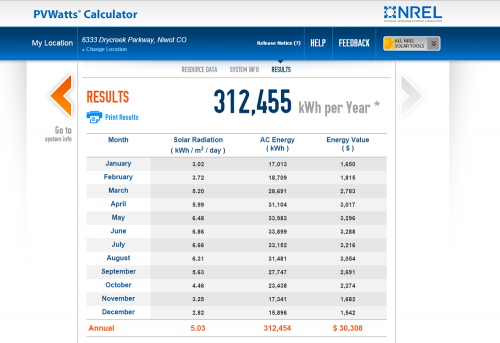
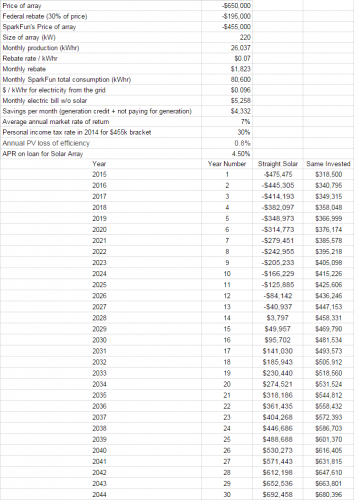


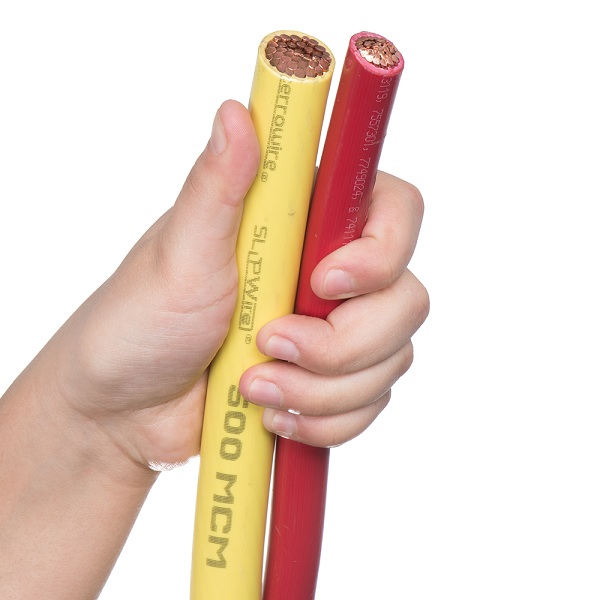
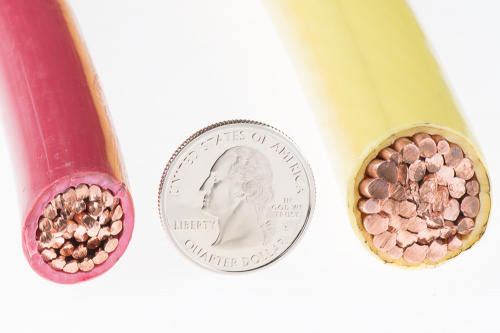





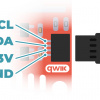
So, each panel generates 327 Watts, but how much did they cost and how big are they? Because you guys sell a 18x22cm (~0.04m²) panel that produces 5.2W and costs $44.95, so at that rate a 327W would most likely be about 60 times as big (maybe 1.5m on each side?) and cost about $2800. Please tell me I'm wrong.
On a completely unrelated note, can you please delete "spam bot" accounts such as Member #644538, who commented here, and about 10 others I have seen in the past but obviously can't remember their IDs? It pisses me off when I want to read comments in your blog posts and I see spam.
Oh, and if you don't delete the accounts, but those users ever buy something from the site, which I highly doubt, send them something completely different to what they bought, preferably damaged parts, and ignore customer service calls/emails from them. lol, just kidding, but actually, why not? ;)
Each panel is 41.2 inches by 61.4 inches. If you want way more information on the panels we used click here. Hope this helps answer your questions.
I believe that the spam accounts get deactivated, but there is nothing stopping them from coming back the next day and making a new account. We try to get rid of them as quickly as possible, but we're only human. Also, feel free to hit the report button, this is one of the ways we are alerted to the spam so we can take care of it.
The spam comment I was talking about got deleted. But now as I type this there is another one! Thanks for the suggestion, I reported it already.
Yep, it's really just a game of Whack-A-Mole (apologies to all moles for comparing them to spammers)
Maybe you can implement an automated script, that if someone posts 3 or more identical comments, it would disable that user's account. After say 24 hours or even better 3 days, it should re-enable it, but if he/she keeps spamming it should disable it permanently.
I say 3 or more and not just 2 because some pairs of products, such as the Cool White and Warm White 3W LEDs (COM-13105 and COM-13104 respectively) both have the same error in the description or somewhere else.
Or maybe just use a captcha-like verification code when registering an account. Or both. Even though that would be annoying for legitimate users, it would hopefully reduce spam.
Anyway, the main reason why I posted the first comment was to get an answer on the size and price of each of the solar panels you used, so could you please answer that question? Thanks ;)
The good thing about the infrastructure investment now is that when more efficient solar panels of the same size become readily available, you will not need any additional building modifications, and minimal hardware additions. Solar panels are pretty nice, especially when you connect them to a Battery bank. This way, if the grid happens to go down, you still have a power supply/ a way to store the energy the solar panels are making.
One last note about solar panels: panels that are placed flat need to have the protective glass on it cleaned every so often. The fine layer of dirt and dust that builds on it reduces the panel's output significantly. It has also been noted that Solar panels that are installed at a shallow angle do not need to be cleaned, that the rainwater from outside actually keeps it clean.
Are the solar panels resistant to hail? Do you have hail in Colorado? We get about one hail storm a year here in Minneapolis.
Yes, the solar panels hold up to hail. We do get a little hail in Colorado, but it is rare that it is very big or lasts very long in our area. Solar panels are usually talked about as fragile at this point which is true to a point, you couldn't, for example, put them on roads and drive cars on them (though there is great fiber optic solar technology coming out that is strong enough to be used on roads which would be a great use for solar energy), but for weather purposes it holds up nice, unless you get a lot of heavy snow. Heavy snow that sits on the panels for days can crack them, and of course shoveling your panels can scrape them which decreases there efficiency, so it's a bit of a catch 22, but usually they are at an angle such that snow can slide off easly. But back to your question! Here is a pretty cool slow motion video of a Conergy PowerPlus Solar Panel Hail Test, as you can see the panels win and the hail shatters.
So, if I'm reading your estimates right, we the people contributed $195,000 towards your solar array (via a federal rebate)? And even so, the investment isn't more profitable than putting the money into some other average investment?
Um... awesome.
Yes that is somewhat correct, there are many various governmental grants and rebates, ours happens to be in the form of a tax rebate on our building as an incentive to buy and use the solar array. This doesn't mean that tax payers paid for our array, just that we pay less taxes after our first year of having them to make up the $195,000 (this has yet to happen for us but we should see it in April when tax season ends). As far as putting the money in a different investment, yes, it could and probably would be more beneficial purely from a monetary standpoint, and that is why there is the rebates and grants because solar is such a costly investment that may not even pay you back in the end as well as something else even with the current grants and rebates. So if savings and making money is purely what you are about, solar isn't the way to go yet, commercially (there are more incentives for individuals that could make this a little bit better money wise), I would wait until solar technology gets better efficiency and the cost goes down before this becomes more of an actual viable investment as well as being good for the environment and reducing your footprint and use of grid based energy (which is mostly from coal right now).
The article contains several typos IMHO: the text below the bar graph mentions 'MW' where it should have said MWh. MW and MWh are not synonyms, they are different entities. MW is used to express power MWh is used to express energy
You are correct, it was a typo. Thank you!
We just installed a 8.5kw array via Astrum solar as part of our stats/town solar initiative (something like 200 homes in our town did it). We also faced the giant pile of money sitting on our roof via waiting for town inspection/state approval and NSTAR signoff to get the monitoring meter. Was over 2 months, which they didn't understand why I felt my money was being lost. Now that it's up, the only complication is it makes the roof quite slick, so large snow sheets come down when the panels warm up, we are investigating how to protect people on our front walk (20' drop)
Protect them with a sign that says "beware of falling snow" and let darwin do the rest.. It's the cheapest and most effective solution.
Perhaps you guys could install a battery array to handle the peak loads and then have it recharge during off-peak hours? Probably not economical for most, but hey, you guys are SparkFun.
We are hooked up to the grid, and that is why we get incentives from Xcel, with our own battery array we would no longer be delivering our energy back to the grid and therefor not really getting the Xcel REC credits.
There are "grid interactive" systems that are grid-tied, but also incorporate batteries. I think these are typically installed to provide emergency power when the grid goes down, rather than to manage peak loads.
With that said, it would be interesting to see how the "billable demand" aspect of commercial electrical service affects the economics of grid-interactive PV.
It was made very clear to me by Xcel that our solar array couldn't impact our peak demand unless we were drawing no energy from the grid and using only our own energy. So even though now, we could be using power from our panels (and potentially and batteries that we could incorporate in our system) they will still charge us for the total peak of what we are using, because that's just how they do it. Yes our demand from the grid is not as high with our solar array, but no they don't make that differentiation when billing us.
Has Sparkfun had commissioning done one their building? Specifically, electrical system commissioning? The way the demand is calculated you can be paying thousands of dollars in what is essentially a "fine" if most of your equipment turns on at the same time say 7 am. If you can adjust the schedule of some equipment, (pumps, fans, motors, etc) in 15 minute increments (I'd stretch that a bit though) you can take a huge dent out of your demand payments. It's the peaks that are what costs so much. Will you be saving energy, typically No, unless you adjust personnel time also. Will you be saving money, yes. Send me a message if you'd like to chat more about this, the company I work for does energy analysis for issues like this.
Peak shaving through energy storage (batteries). Benefits SparkFun. And benefits the grid. And it's right in SparkFun's wheelhouse of solving problems. You essentially just time-shift your electrical load to make it less peaky. Less stress on grid infrastructure. Smaller bills for you because of lowered Demand charges. Climb on board the evolving smart grid train!
Thank you for the nice description of Sparkfun's solar array.
Could you do a follow-up post detailing your energy usage? Broken down by time of day, and end use?
Once you understand Sparkfun's electricity usage patterns you may be able to reduce demand charges by scheduling peak loads to coincide with peak solar production. Or by adding storage to time-shift your PV watts to times of highest net demand.
There are companies that will do this analysis for you, and make their profit from a percentage of the savings...
We actually have an online monitoring system through Lucid BuildingOS, and it tracks our PV input, our total energy usage, water usage, and natural gas usage, and takes measurements every few mins. We have this currently available in our front lobby for people to see, but soon we will have a site that anyone could see what is going on, so I am excited for that. We also have a company looking into our usage and once we have a good amount of data they are going to recommend action we should take to reduce our impact.
It would be rather neat if some of the figures (massaged) get plugged into data.sparkfun.com :)
Which inverter was chosen for this system? Kudos to SparkFun for plugging into the sun.
Here is our invderter information: Inverter model: Sunpower (ABB/Power One Trio 27.6-TL) Inverter power rating: 27.6 kW Number of inverters: 8 Total inverter power name plate capacity: 8 x 27.6 = 220.8 kW Number of strings per inverter: 7
The bad part of Xcel's plan is that they require a commitment to leave the solar on the building for 20 years which isn't a bad deal unless you don't plan to stay in the building for more than 20 years. In our case, we were not told up front that this was an Xcel requirement. We will most likely not stay in the house for 20 years so I refused to sign it since I couldn't guarantee that anyone who bought the house would leave the solar there. You wouldn't think anyone would take it off but .....
We also used Sun Power and got a reduction in our price if Sun Power would get the money from the excess energy generated. When I refused to sign the Xcel deal, Xcel took the 2 way meter out. Now they get the excess energy for free. Sun Power absorbed the loss. In essence Sun Power is getting screwed. By me or Xcel? I hope it's not me.
I talked to Xcel about this in depth and explained to them that I would guarantee that I would leave them on as long as we lived there, but that wasn't good enough for them. I also explained that I didn't see how I could force anyone to leave them on there for 20 years but I didn't run that by an attorney.
Real Good Solar installed ours. They're now known as RGS and they've changed their business model. They did an excellent job for us including an in depth analysis of the structural capability of our roof.
Sun Power has been awesome company with whom to work.
As somebody who recently installed solar panels on his roof for residential, there's one other figure that should be taken into account: property value. Although I ultimately found a great deal due to EU subsidies, a regional initiative (Energy Valley) and others that will lead to these paying themselves off in a few years rather than decades, it's really the property value increase, not too long before I'm putting the house on the market, that made it a no-brainer.
I don't know if this in any way affected SparkFun's plans; I rather hope they're not going to leave the new building any time soon. However, it's possibly a nice line item on the sub-lease areas if they have chosen to indeed sub-lease them.
That is a really good point when it comes to residential installations. And although we don't plan on leaving our new building anytime soon that does play a role in it's cost/benefit analysis. Thanks for the input!
which company installed the pannels? solarcity?
Independent Power Systems is the company we went with, which is a local company here in Boulder, CO.